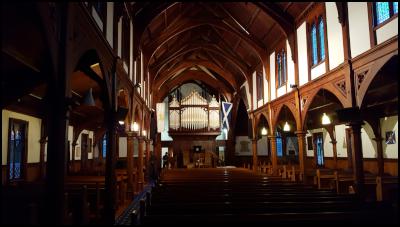St Andrew’s at Rangi Ruru Has New Owners
St Andrew’s at Rangi Ruru Has New Owners

One of the most beautiful wooden chapels in the country is now in the ownership of Rangi Ruru Girls’ School.
St Andrew’s at Rangi Ruru, which is a Category 1 Heritage Building, was moved to the school site in 1986 (thanks to a generous donation from a parent) and quickly became an integral part of life at Rangi Ruru.
Board of Trustees chair, Stuart Nattrass says in day to day terms, not much is going to change however St Andrew’s will now be looked after and managed by the school.
“There are three key “pre-earthquake” buildings on our campus that were particularly important to retain; obviously the category 2 heritage listed original homestead Te Koraha which was completely repaired and restored in 2014, our boarding house on the Rhodes Street boundary of the school; and the chapel was the third,” says Mr Nattrass. “The Parish and Church Property Trust have been fantastic to work with on this and we look forward to continuing that relationship with them as the parish will keep using the church.”
With a function centre also available at Rangi Ruru, it is hoped St Andrews at Rangi Ruru will see more weddings, in what is one of the most beautiful original churches in the city.
St Andrews was designed by HJ Cridland, the first architect to work in Canterbury. The wooden Presbyterian church was built in 1857 and remains a significant part of New Zealand history.
“It’s of particular importance as we lost so many churches in the earthquakes,” says Stuart Nattrass. “It was wonderful to share in the recent celebrations marking 30 years since this beautiful church arrived here at Rangi Ruru.”
Backgrounder:
http://www.heritage.org.nz/the-list/details/304
St Andrew's was the first Presbyterian church to be built in Christchurch (1856-1857). It was designed by H.J. Cridland (1823-1867), who was probably the first architect to work in Canterbury. Cridland arrived in Wellington in 1843 and was employed in the Colonial Survey Office. He designed a number of buildings in Wellington including St Peter's Church (1848) and the Hutt Anglican Church (1849.) In the middle of 1849 Cridland moved to Lyttelton to become the Superintendent of Public Works for the Canterbury Association. Although working primarily as a surveyor, he possibly designed and certainly supervised the construction of various buildings for the Canterbury Association in Lyttelton. According to art historian, Jonathan Mane-Wheoki, St Andrew's appears to have been the last building Cridland designed.
St Andrew's opened for worship on 1 February 1857. At this stage the wooden building was only 54 feet by 22 feet (about 16.5 m x 6.7 m) and stood at the intersection of Tuam Street and Oxford Terrace. Around 1862 a nave was added. At this time the original building was divided and became the transepts of the enlarged church.
In 1892 St Andrew's was enlarged and extended again so that the original 1857 building became contained within the transepts of the 1890s church. This extension/reconstruction of the main portion of the nave and the west end of the church, with its distinctive wheel window, was designed by R.W. England. England later joined forces with his brother to form the Christchurch architectural firm England Bros, which became well-known for both domestic work, such as McLean's Mansion, and commercial buildings, such as the former D.I.C. building in Cashel Street.
With the growth of the surrounding suburbs from the 1920s, St Andrew's congregation began to dwindle and the church was no longer the centre of Presbyterian worship that it had once been. By the 1980s it was marooned in the middle of a commercial area and the congregation had become so small that the future of the church was in doubt. At this time Rangi Ruru Girls' School was looking for a new school chapel, and in 1986 St Andrew's was cut into sections and transported across town to its present site at Merivale Lane. It reopened in 1987 and now functions both as the school's chapel and a parish church.
Historically the church's significance lies in its connection with the early Presbyterian Church in New Zealand. It is also associated with the first Pakeha to settle permanently on the Canterbury Plains, the Deans family, who were closely involved with the establishment and congregation of St Andrew's.
Architecturally St Andrew's is significant as a rare example of R.W. England's ecclesiastical work in timber.
ends


 Gordon Campbell: On The Government’s Epic Fails In Jobs And Housing
Gordon Campbell: On The Government’s Epic Fails In Jobs And Housing NZ Infrastructure Commission: New Infrastructure Research Can Aid Disaster Preparedness
NZ Infrastructure Commission: New Infrastructure Research Can Aid Disaster Preparedness Southern Lakes Sanctuary: Endangered Endemic Birds Flock To Makarora Following Proactive Predator Trapping
Southern Lakes Sanctuary: Endangered Endemic Birds Flock To Makarora Following Proactive Predator Trapping Kāinga Ora: Kāinga Ora Refocusing On Its Core Mission
Kāinga Ora: Kāinga Ora Refocusing On Its Core Mission New Zealand Labour Party: Still No Commitment To Build More Public Houses
New Zealand Labour Party: Still No Commitment To Build More Public Houses Crown Response to the Abuse in Care Inquiry: New Website In Response To Royal Commission Call For Records Support
Crown Response to the Abuse in Care Inquiry: New Website In Response To Royal Commission Call For Records Support New Zealand Government: Online Portal For COVID-19 Inquiry Opens
New Zealand Government: Online Portal For COVID-19 Inquiry Opens


